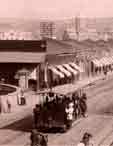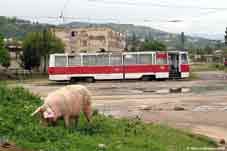Nostalgic Tbilisi residents want their tramway back
By Temuri Kiguradze
Friday, August 1



Just two years later the 600 employees of the tramway and trolleybus park gathered to protest the closing of the lines.
City Hall transport department representative Beso Jghenti told reporters at the time that the city offered ex-tram drivers new jobs on city buses if they had proper driving licenses.
“The reason for closing the tramway line was the low popularity of the line and the worn-out wagons. The rehabilitation cost was too high and the tramway and trolleybuses were not beneficial,” a City Hall spokesperson told the newspaper yesterday.
Yet a small, dedicated number of Tbilisi residents want the old ways back.
“I rode the tramway since early childhood and I fell in love with it,” says Beka Ninikuri. He is a member of an online movement, which began late last year, calling for the tramway to be reinstated.
About 400 have joined the call so far.
“The tramway is a very comfortable and economic mode of transport,” says Irakli Zhozhuashvili, a tramway enthusiast and, at one-time, an occasional driver thanks to a friend who worked on one of the lines. He says Tbilisi is worse off without the environmentally-friendly trams. And were they used?
“The tramway line in Avchala district was always overcrowded, so it’s really absurd to talk about the low popularity of the route,” he says.
Environmental expert Professor Bakur Beritashvili agrees that they cut down on gas and noise pollution.
“Tram lines exist in almost every European capital including Paris, Prague and London. I don’t know why our officials decided to get rid of it in Tbilisi,” he said.
Zhozhuashvili plans to petition City Hall with a formal request to restart the tram lines.
“But…I don’t really think that they will care about it,” Zhozhuashvili laments.
The story of the tramway began in 1883 with the first horse-drawn tramcar.
A Belgian company called Helios took on the task of stringing up electric lines. By 1904 the first electrified tramway line was set, and by the close of the Soviet era Tbilisi had more than 100 kilometers of line ad about 300 tramcars.
But in Georgia’s impoverished post-independence much of the state’s infrastructure simply fell apart.
“By the end of the 90s the tramway transport fell into a deep crisis,” says Vakhtang Abuladze, the former chief of the capital’s tramway department. By 2000, he recalls, only three city routes were left. A 2002 earthquake knocked out one.
“Four years later both of them were closed. The government explained it as a reduction in [state-subsidized services], and partially that’s true, as the cost of a tram trip was only 10 tetri.”
A City Hall press secretary said while there is no current plan to bring back the tramways, the city is not ruling it out.
Tram enthusiasts hold hope.
“Apart from the fact that tramway is cheap, effective, and environmentally clean, it also makes city more beautiful. The structure of the rails perfectly fits the image of the city,” says Ninikuri, who is studying to be an architect.
